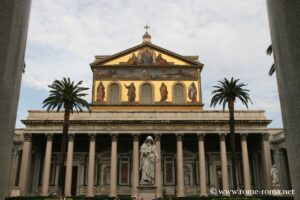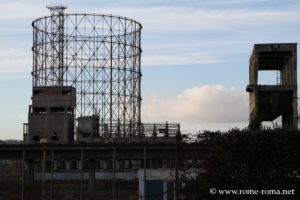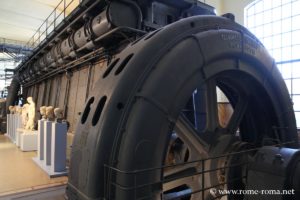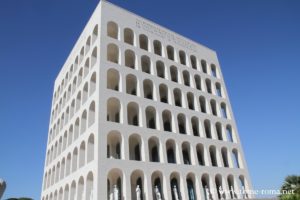Beyond the Testaccio district and the walls of Rome, Via Ostiense leads to the Papal Basilica of Saint Paul Outside the Walls, passing by the Centrale Montemartini museum, near the charming residential district of Garbatella. Further along, Via Cristoforo Colombo crosses the large E.U.R. district dating back to the Fascist era.
Ostiense, Garbatella and San Paolo
The former port area of Ostiense
Leaving Rome to the south through the Porta San Paolo, the Roman road of Via Ostiense led to the Port of Ostia. Today it is a boulevard that crosses the eponymous district, initially passing through an old industrial area from the early 20th century, dominated by the large gasometer.
The area contiguous to Testaccio is young and lively, with an underground atmosphere, nightlife, restaurants, and clubs, particularly around the former slaughterhouses (Mattatoio, 1891-1975) and warehouses, often adorned with large murals.
Further south, beyond the Aurelian Walls and the railway, lies the area of the former river port, wholesale markets (Mercati Generali, 1921), factories (pasta, dairy, glass, etc.) and the gasometer (1936).
The former Montemartini Power Station has been converted into a remarkable museum, displaying industrial tools alongside sculptures and ancient artworks, mainly from excavations of the late 19th – early 20th centuries.
The Garbatella district
Nearby, the Garbatella metro station is at the foot of the pleasant eponymous neighborhood with a village-like atmosphere. It was built in the 1920s under the name Concordia, with small houses featuring gardens originally intended for workers of nearby industries. It offers a pleasant walk to discover its eclectic architecture, small shops, and historic public buildings such as the Palladium cinema, now a theater. Along the former Via delle Sette Chiese (Street of the Seven Churches), the Commodilla Catacombs can be visited by reservation.
San Paolo
A little further, Via Ostiense passes in front of the Basilica of Saint Paul Outside the Walls, one of the four papal basilicas of Rome, and the largest after St. Peter’s. It was rebuilt in the mid-19th century after a fire and preserves a splendid 13th-century cloister.
Next to it, the small Schuster Park borders a necropolis from the 2nd–3rd centuries.
E.U.R.
Further south, the E.U.R. district is reached via the major thoroughfare of Via Cristoforo Colombo.
It was founded under the Fascist regime, with streamlined architecture that also glorified the imperialist ideas of the time. This project, launched by Benito Mussolini, was intended for the Rome World’s Fair, featuring a large, well-equipped urban area with all public services and green spaces (see E.U.R. district).
Main Monuments and Sites
- Basilica of Saint Paul Outside the Walls
 St. Paul’s Basilica outside the walls in Rome is one of the ...
St. Paul’s Basilica outside the walls in Rome is one of the ...
Museums
More sites in the district
Practical / Hotels
- Good hotels in the Garbatella district, sorted BY PRICE
- Good hotels in the Ostiense district, sorted BY PRICE
- Good hotels in the E.U.R. district, sorted BY PRICE
Sites of the Ostiense and E.U.R. districts
If you see this after your page is loaded completely, leafletJS files are missing.






